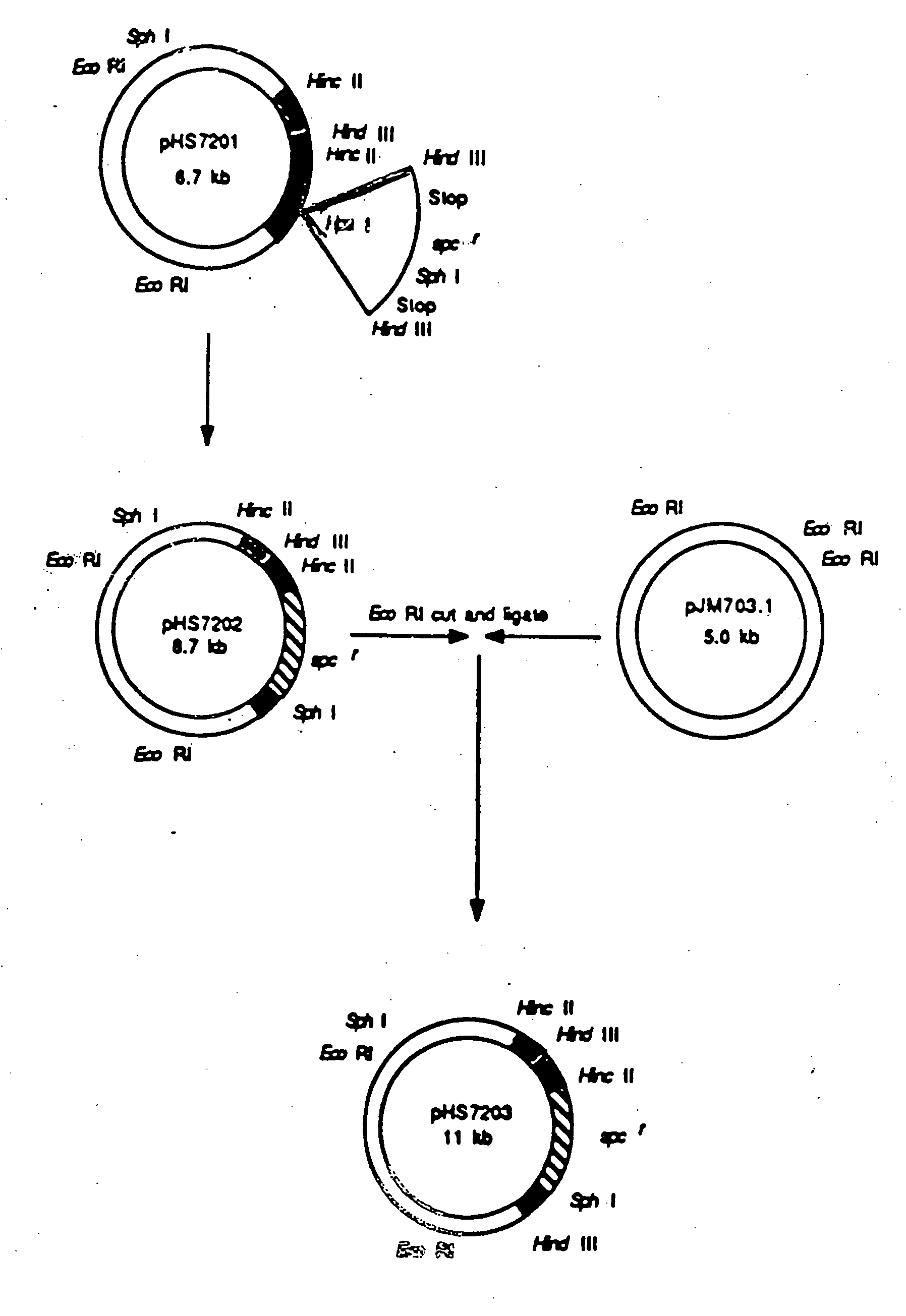Transformed Shigella
a technology of shigella and shigella, which is applied in the field of shigella transformation, can solve the problems of no experiments carried out, no evidence adduced to show, and disease presents a particularly serious public health problem
- Summary
- Abstract
- Description
- Claims
- Application Information
AI Technical Summary
Benefits of technology
Problems solved by technology
Method used
Image
Examples
example 1
Cloning of the Shiga-Toxin Operon
[0022] Total DNA was prepared (50) from a wild type antibiotic-sensitive S. dysenteriae 1 strain SC500 obtained from Centre National de Référence des Shigelles of Institut Pasteur, Paris, France. 10 μg of DNA were digested with EcoRI (Amersham, Buckinghamshire, UK) and loaded on a 0.7% agarose gel. Fragments ranging from 3.5 to 4.5 kb were electroeluted. 0.1 μg of purified fragments was ligated to 1 μg of cos-ligated, EcoRI cut, dephosphorylated λ GT11 arms (Stratagene Cloning System, San Diego, USA) and packaged using Packagene System (Progema Biotec, Madison, USA) according to the suppliers recommendations. The packaged DNA was then transfected into E. coli Y1090(59). The λ GT11 bank was then screened with 13C4, a monoclonal antibody specific for the B subunit of SLT1 (54) obtained from A. D. O'Brien, U.S.U.S.H., Bethesda, Md., USA. 103 recombinant phages were plated on Y1090 in LB soft agar. Plates were incubated at 37° C. for 12 hours. A nitroce...
example 2
In vitro Mutagenesis of the Shiga-Toxin A Subunit Gene
[0024] In subclone pHS7201, the entire Shiga-toxin operon is contained in a 4.2 kb EcoRI DNA fragment. In vitro mutagenesis of the A subunit gene was done by inserting the interposon Ω(37) which codes for spectinomycin resistance and is flanked on each side by T4 translation transcription stop-signals. Ω was purified as an HindIII 2 kb fragment, and its ends were filled in by the Klenow fragment of DNA polymerase I. Ω was then ligated to HpaI linearized pHS7201 to generate the recombinant plasmid pHS7202 as shown in the FIGURE. The 6.2 kb EcoRI fragment containing the mutagenized sequence was then purified and ligated with the EcoRI site of the suicide plasmid vector pJM703.1 (51) to generate recombinant plasmid pHS7203 as shown in the FIGURE. pJM703.1 replicates only if its deficient R6K origin is complemented in-trans by the pir function contained in the lambda phage integrated in the genome of E. coli SM10 (21). This strain a...
example 3
Assays of Cytotoxicity, Growth within HeLa Cells, Macrophage Detachment and Toxicity in Rabbit Ileal Loop and in Monkey
[0028] SC500 and SC501, as well as their non-invasive derivatives SC502 and SC503 respectively (obtained by the spontaneous-cure (i.e., loss) of their large virulence plasmid pHS7200 which is necessary for invasion of cells), were grown for 48 hours in 200 ml of iron-depleted medium. Glassware was pretreated with 6N HCl and rinsed extensively with iron free H2O. The medium contained M9 salts supplemented with 15 μg / ml CaCl2, 5 mg / ml casamino-acids, 2 mg / ml glucose, 50 μg / ml thiamine, 20 μg / ml L-tryptophane, 10 μg / ml nicotinic acid and 150 μg / ml human transferrin (Sigma). The bacteria were washed twice in saline and resuspended in 3 ml of PBS. Lysozyme was added at a final concentration of 0.2 mg / ml. After a 30 minute-incubation at room temperature (25° C.), 30 μl EDTA 0.5 M pH8 was added, and the cells were transferred to an ice bath and sonicated. Sonic extracts w...
PUM
| Property | Measurement | Unit |
|---|---|---|
| concentration | aaaaa | aaaaa |
| concentration | aaaaa | aaaaa |
| temperature | aaaaa | aaaaa |
Abstract
Description
Claims
Application Information
 Login to View More
Login to View More - R&D
- Intellectual Property
- Life Sciences
- Materials
- Tech Scout
- Unparalleled Data Quality
- Higher Quality Content
- 60% Fewer Hallucinations
Browse by: Latest US Patents, China's latest patents, Technical Efficacy Thesaurus, Application Domain, Technology Topic, Popular Technical Reports.
© 2025 PatSnap. All rights reserved.Legal|Privacy policy|Modern Slavery Act Transparency Statement|Sitemap|About US| Contact US: help@patsnap.com


